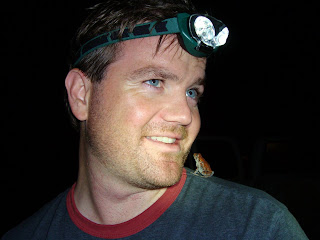I'm sure you're surprised to see me posting herp content on our blog. I guess it isn't the first time, and it likely won't be the last. Somehow I've found the time to go after a few more species and subspecies that I haven't seen before, along with some familiar but still enjoyable ones along the way. The Florida panhandle may not be a hotbed of rich cultural heritage, but it sure has its fair share of good biodiversity.

My friend Brandon spotted this cottonmouth (
Agkistrodon piscivorus) when it had little more than the head of this unfortunate banded watersnake (
Nerodia fasciata fasciata) in its mouth. It was neat to watch it use its fangs to help swallow.

In the same genus as the cottonmouth, these southern copperheads (
Agkistrodon contortrix contortrix) can be hard to find in Florida, and I'd been looking forward to seeing this subspecies in the wild for some time. I included the first photo to show how well they can blend into leaf litter. If you weren't looking right at them, you could easily overlook them. The photo below gives a better full body shot.

We recently went in search of the seemingly elusive river frog (
Rana heckscheri), which took us to a really neat set of small streams and the springs they were fed by.


Here's our target! Not exactly a beautiful knockout, but interesting enough to motivate me to put some effort into finding it and seeing where it lives.

Along with the river frogs, there were also good numbers of bronze frogs (
rana clamitans clamitans) and this southern leopard frog (
rana utricularia).

In the same area as the frogs, we found good numbers of loggerhead musk turtles (
Sternotherus minor). The babies were feisty but cute.

adult female

adult male with proportionately huge head, for which the species is named
This large male was the first wild gopher tortoise that I've seen.


Here's a young and vibrantly-colored yellowbelly slider (
Trachemys scripta scripta).

I went to the Pea River at night, just over the border into Alabama, to look for Escambia map turtles (
Graptemys ernsti). I found this little fella, but he ended up being a hybrid between Barbour's and Escambia map turtles.

We then went to the Escambia River to ensure that anything we found would be full-blooded
G. ernsti, and found four of them, including the one below.

River cooters (
Pseudemys concinna) seem to be pretty common in some areas. We found seven or eight sleeping in one little set of rocks. I think the eye looks really neat on the second photo. It almost reminds me a bit of the
flag of Brazil, or a solar eclipse.



This was the first chicken turtle (
Deirochelys reticularia reticularia) that I've seen in Florida so far. Hmm...I wonder what they taste like?

I believe this is the first Fowler's toad (
Bufo fowleri) I've seen since moving down here. They seem pretty sparse in this part of their range, and are far outnumbered by southern toads (
Bufo terrestris).

Here's a squirrel treefrog (
Hyla squirella) that's not sitting on mowed grass or vinyl siding for once.
The next three snakes are all young individuals.

brown watersnake (
Nerodia taxispilota)

Florida redbelly snake (
Storeria occipitomaculata obscura)


black swamp snake (
Seminatrix pygaea pygaea)
The swamp snake was a special one to find, as they are habitat specialists, and are unlikely to be seen without intentionally seeking one out.

young eastern glass lizard (
Ophisaurus ventralis)

Last but not least, the nearly full-spectrum rainbow markings from nose to tail on a black background, makes a hatchling broadhead skink (
Eumeces laticeps) one of the most attractive lizards in my opinion.
 As a senior in college, I lived with 9 girls in a house we dubbed, "The Mansion." Before we graduated, we recognized that time and geographic distance would make it challenging for us to keep up on these friendships that were so transformative in our lives. Therefore, we committed to coming together again at least once a year. Every year for six years we've made good on that promise -- gathering together for a long weekend of celebrating our dear friendships, catching up on the details of life, and -- as always with this group -- discussing challenging issues and sharing our souls. This weekend was no exception. We converged on Kansas City and spent an amazing four days of long talks, little sleep, delicious food, hillarious moments and incredible connection. Unfortunately we were missing three vital pieces this year -- Jes, Renee, and Smose, your absence was deeply felt!
As a senior in college, I lived with 9 girls in a house we dubbed, "The Mansion." Before we graduated, we recognized that time and geographic distance would make it challenging for us to keep up on these friendships that were so transformative in our lives. Therefore, we committed to coming together again at least once a year. Every year for six years we've made good on that promise -- gathering together for a long weekend of celebrating our dear friendships, catching up on the details of life, and -- as always with this group -- discussing challenging issues and sharing our souls. This weekend was no exception. We converged on Kansas City and spent an amazing four days of long talks, little sleep, delicious food, hillarious moments and incredible connection. Unfortunately we were missing three vital pieces this year -- Jes, Renee, and Smose, your absence was deeply felt!





























